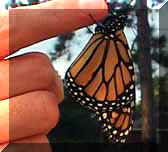
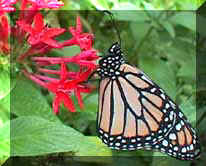 Probably the most recognized butterfly in North America. Every
school-age child will know the Monarch when they see one. It has been nominated to
be the national insect, and may well become a national icon.
Probably the most recognized butterfly in North America. Every
school-age child will know the Monarch when they see one. It has been nominated to
be the national insect, and may well become a national icon.
 Probably the most recognized butterfly in North America. Every
school-age child will know the Monarch when they see one. It has been nominated to
be the national insect, and may well become a national icon.
Probably the most recognized butterfly in North America. Every
school-age child will know the Monarch when they see one. It has been nominated to
be the national insect, and may well become a national icon.
We've all heard about he remarkable migration Monarchs make every year. This journey of up to 2,000 miles is driven by instinct, and how they find their way is still very much a mystery. They seem to be guided by celestial navigation in their flight, maybe utilizing the orientation of the sun. As they reach the mountains where they will spend the winter, it is believed that they are guided by magnetic fields in the area. Each Monarch has tiny particles of magnetite in the expanded bases of its wing veins. These magnetic particles may act as tiny compasses and point them toward large deposits of metallic ore in the vicinity of their winter colonies in Michoacan, Central Mexico. What finally guides the migrating butterflies to the trees on which they will roost, the same trees their grandparents used the year before, may be the scent of billions of scales from the previous year's butterflies. In very early spring, the overwintering adults mate and begin to move north and lay eggs. Their offspring then continue moving north, reaching much of the East in April or May.
I see the Monarchs in my garden throughout most of the year. They
become more numerous in late February. Host plant is 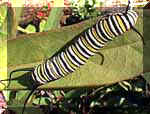 Asclepias,
or milkweed, which is also a great nectar plant. There are many species of
milkweed; at least one for every garden. The important thing to remember is to plant
plenty. Monarch caterpillars are not dainty eaters - you will need lots of
milkweed. This is one of the easiest caterpillars to raise. They are
plentiful, you can find them in most areas of the country, like the milkweed. I find
the first eggs on milkweed in March, before it has time to grow big enough to feed all the
little piggies. The caterpillars are ringed with yellow, black and white on each
segment, and has a pair of black tubercles on each end. They will feed on 100
different species of milkweeds throughout their rang in North America, but seem to prefer
the swamp milkweed (Asclepias incarnata) in my garden. These guys are REAL eating
machines! I've found that if you put too many together in one container, they will
cannibalize each other, or new chrysalis', so don't overcrowd them. The larger
caterpillars will eat eggs and smaller caterpillars.
Asclepias,
or milkweed, which is also a great nectar plant. There are many species of
milkweed; at least one for every garden. The important thing to remember is to plant
plenty. Monarch caterpillars are not dainty eaters - you will need lots of
milkweed. This is one of the easiest caterpillars to raise. They are
plentiful, you can find them in most areas of the country, like the milkweed. I find
the first eggs on milkweed in March, before it has time to grow big enough to feed all the
little piggies. The caterpillars are ringed with yellow, black and white on each
segment, and has a pair of black tubercles on each end. They will feed on 100
different species of milkweeds throughout their rang in North America, but seem to prefer
the swamp milkweed (Asclepias incarnata) in my garden. These guys are REAL eating
machines! I've found that if you put too many together in one container, they will
cannibalize each other, or new chrysalis', so don't overcrowd them. The larger
caterpillars will eat eggs and smaller caterpillars.
Females will lay eggs singly on underside of milkweed, she won't lay on
plants heavily infested with aphids. 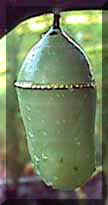 Most milkweeds contain cardiac
glycosides which are stored in the bodies of both the caterpillar and adult. These
poisons are distasteful and emetic to birds and other vertebrate predators. After a
couple of weeks of stripping your milkweed, the caterpillars will form a beautiful,
jewel-like chrysalis. As the newly hardened pupa of the Monarch butterfly glistens
in the morning sun, you can see tiny gold dots scattered across a soft green background.
You can see why the word "chrysalis" means 'object of gold.' This
is actually how the Monarch got their name. American colonists noticed this
adornment, which looked like the crown of a king. By the way, nobody knows the
function of the gold spots. At the end of the chrysalis stage, as the scale
pigmentation develops, you can actually see the butterfly through the pupa covering.
About an hour or two before it emerges, the adult's legs and body parts show
clearly. Now is the time to watch for the awe-inspiring emergence.
Most milkweeds contain cardiac
glycosides which are stored in the bodies of both the caterpillar and adult. These
poisons are distasteful and emetic to birds and other vertebrate predators. After a
couple of weeks of stripping your milkweed, the caterpillars will form a beautiful,
jewel-like chrysalis. As the newly hardened pupa of the Monarch butterfly glistens
in the morning sun, you can see tiny gold dots scattered across a soft green background.
You can see why the word "chrysalis" means 'object of gold.' This
is actually how the Monarch got their name. American colonists noticed this
adornment, which looked like the crown of a king. By the way, nobody knows the
function of the gold spots. At the end of the chrysalis stage, as the scale
pigmentation develops, you can actually see the butterfly through the pupa covering.
About an hour or two before it emerges, the adult's legs and body parts show
clearly. Now is the time to watch for the awe-inspiring emergence.
Sexing the caterpillars can only be done by dissection. The sex can
be determined of the chrysalis, according to monarchwatch.org. " To determine the sex of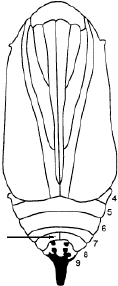 pupae requires only
keen eyes or a dissecting microscope. Surrounding the cremaster (the structure from which
the pupa hangs) are a series of rings, called abdominal sternites. Within the first ring
(9th abdominal sternite) are several paired black dots next to the cremaster; turn the
pupa so that you are looking at these dots. If the Monarch is a female, the ring adjacent
to the 9th sternite will have a line dissecting it; this line (indicated by the arrow on
the diagram) will be centered between the pairs of dots. Male Monarch pupae do not have
this line." It's
easy to tell
pupae requires only
keen eyes or a dissecting microscope. Surrounding the cremaster (the structure from which
the pupa hangs) are a series of rings, called abdominal sternites. Within the first ring
(9th abdominal sternite) are several paired black dots next to the cremaster; turn the
pupa so that you are looking at these dots. If the Monarch is a female, the ring adjacent
to the 9th sternite will have a line dissecting it; this line (indicated by the arrow on
the diagram) will be centered between the pairs of dots. Male Monarch pupae do not have
this line." It's
easy to tell 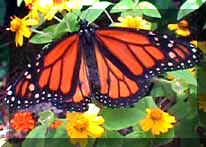 the males butterflies from the females. The male has a raised black
spot on each hindwing. This spot is a cluster of scent scales, used in courtship. It
releases the pheromones that attract the female Monarch. The veins of the female's
wings are much bolder than the male's, and in flight appear to be darker orange. On
the wing, males seem to be bright orange because their wing veins are thinner.
the males butterflies from the females. The male has a raised black
spot on each hindwing. This spot is a cluster of scent scales, used in courtship. It
releases the pheromones that attract the female Monarch. The veins of the female's
wings are much bolder than the male's, and in flight appear to be darker orange. On
the wing, males seem to be bright orange because their wing veins are thinner.
Monarchs reside in open fields, roadsides, and suburban areas. While migrating it can be anywhere, but strongly concentrates on the immediate coast and along river valleys. The eggs take about three to five days to hatch. Caterpillar stage lasts about two weeks. They stay in the chrysalis for 12-14 days before the adult emerges.
 I'm exciting about learning how to
tell the sex of butterflies while still in the pupa stage. I am watching my
chrysalis anxiously to see if a female emerges. I see the line in the middle of the
sternites, but not where the line is in the diagram above. Is my chrysalis a male or
female?? I'll let ya know! It's due to emerge the week of April 10th. Click on the chrysalis pic to the left to see the full size
picture. It's 79 KB, and might take a minute to download. I plan to learn to
tell the difference in the sexes, then post examples of each on this page.
I'm exciting about learning how to
tell the sex of butterflies while still in the pupa stage. I am watching my
chrysalis anxiously to see if a female emerges. I see the line in the middle of the
sternites, but not where the line is in the diagram above. Is my chrysalis a male or
female?? I'll let ya know! It's due to emerge the week of April 10th. Click on the chrysalis pic to the left to see the full size
picture. It's 79 KB, and might take a minute to download. I plan to learn to
tell the difference in the sexes, then post examples of each on this page.
Information for this page came from my garden and experiences with raising Monarch caterpillars. I had some help with the 'specifics' from these books: Florida's Fabulous Butterflies, Butterflies through Binoculars, Garden Butterflies of North America, and Florida Butterfly Gardening and monarchwatch.org
Diagram taken from:
Hughes, P. R., C. D. Radke, and J. A.
A. Renwick. 1993. A Simple, Low-Input Method for Continuous Laboratory Rearing of the
Monarch Butterfly (Lepidoptera: Danaidae) for Research. American Entomologist 39: 109-111.
This page updated 9 April 2000